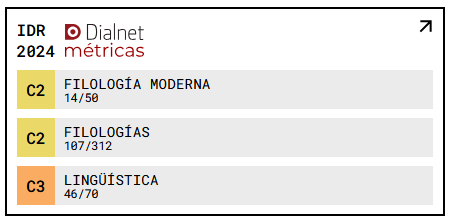What kind of love is at work in "Pride and Prejudice" and "Wuthering Heights"?
DOI:
https://doi.org/10.18172/jes.95Abstract
Pride and Prejudice and Wuthering Heights are two novels where love has a central and important role. However, they portray two different types of love. In Pride and Prejudice there is love and love turns to marriage. The characters in this novel are able to fall in love and defend their love within the boundaries of what is considered socially acceptable. In Wuthering Heights Emily Bronte is intense in her treatment of passion which is a passion that turns to violence. The characters show some of the more deeply buried emotions and tendencies. Love and passion will be analysed using a digitalised copy of both novels to determine what kind of feelings are present in both novels.Downloads
References
Biber, D., S. Conrad, and R. Reppen. 1998. Corpus Linguistics. Investigating Language Structure and Use. Cambridge: Cambridge University Press.
Burgess, A. 1974. English Literature. Harlow: Longman.
Butler, M. 1997. Jane Austen and the War of Ideas. Oxford: Oxford University Press.
Cantos, P., and A. Sánchez. 2000. “Investigating type-token regression and its potential for automated text discrimination”. Corpus-based Research in English Language and Linguistics (Monográfico. Cuadernos de Filología Inglesa). Murcia: Servicio de Publicaciones de la Universidad de Murcia.
Carter, R., and J. McRae. 1997. The Routledge History of Literature in English. London: Routledge.
Hardy, J. 1984. Jane Austen’s Heroines. London: Routledge and Kegan Paul.
Jones, V. 1997. How to study a Jane Austen novel. Houndmills: Macmillan Press Ltd.
Kelly, G. 1995. “Jane Austen, Romantic Feminism and Civil Society”. Jane Austen and Discourses of Feminism. Ed. Looser, D. London: Macmillan Press Ltd.
Kinkead-Weekes, M. 1986. “The place of love in Jane Eyre and Wuthering Heights”. The Brontës. A Collection of Critical Essays. Ed. Gregor, I. Englewood Cliffs: Prentice Hall International.
Leech, G., and M. Short. 1991. Style in fiction: a linguistic introduction to English fictional prose. London: Longman.
Leavis, F. R. 1972 (1948). The Great Tradition: George Eliot, Henry James and Joseph Conrad. Harmondsworth: Penguin.
McMaster, J. 1996. Jane Austen the novelist. London: Macmillan Press Ltd.
Sinclair, L. 1991. Corpus, Concordance, Collocation. Oxford: Oxford University Press.
Stokes, M. 1991. The Language of Jane Austen. Basingstoke: The Macmillan Press, Ltd. http://www.bluejoh.com/dungeon/archives/00381.php Tuite, C. 2002. Romantic Austen. Sexual Politics and the Literary Canon. Cambridge: Cambridge University Press
Downloads
Published
How to Cite
Issue
Section
License
The authors retain copyright of articles and authorize Journal of English Studies the first publication. They are free to share, redistribute, and/or reprint the article without obtaining permission from the publisher as long as they give appropriate credit to the editor and the journal.
Self-archiving is allowed too. In fact, it is recommendable to deposit a PDF version of the paper in academic and/or institutional repositories.
It is recommended to include the DOI number.
This journal is licensed under a Creative Commons Attribution 4.0 International License














